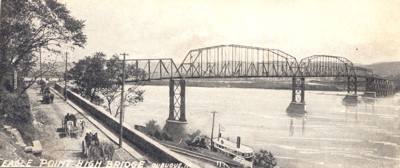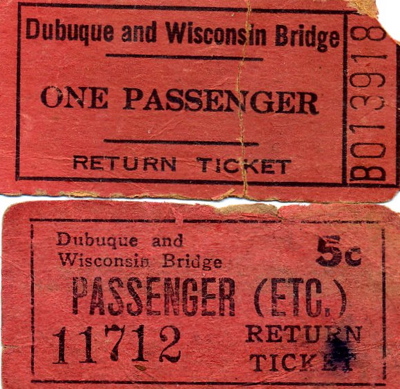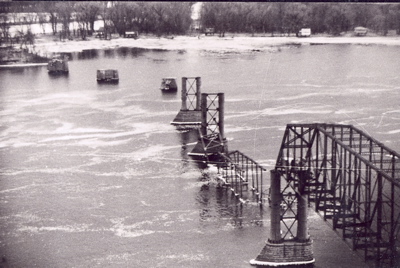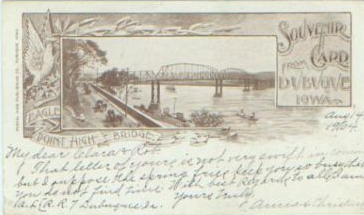Encyclopedia Dubuque
"Encyclopedia Dubuque is the online authority for all things Dubuque, written by the people who know the city best.”
Marshall Cohen—researcher and producer, CNN
Affiliated with the Local History Network of the State Historical Society of Iowa, and the Iowa Museum Association.
EAGLE POINT BRIDGE
EAGLE POINT BRIDGE. One of the last privately owned toll bridges across the MISSISSIPPI RIVER. In 1894 Joseph A. RHOMBERG organized the Dubuque and Wisconsin Bridge Company to construct a bridge into Wisconsin from Dubuque.
Financial problems affected progress on the bridge from the start. It was six years between the time the first money was solicited in 1894 and construction started in 1900. Of the total $110,000 needed, $25,000 came from the Dubuque city government. The rest was raised from stockholders who paid $100 per share. Once construction started, plans had to be reduced. The eastern portion of the bridge was made of wood instead of the iron used on the western side. The bend in the bridge near the Wisconsin side was to save additional money. The deck of the bridge was originally laid with wooden blocks. These were replaced in 1946 with a grated steel floor. The bridge stretched from Dubuque's EAGLE POINT to an area in Wisconsin formerly known as Kimball's Slough or KIMBALL'S PARK. The 1,100 foot long bridge had 1,800 feet of trestle extending into Wisconsin.
The opening of the bridge was not celebrated as might have been expected. Bridge company officials chose not to invest their money in a ceremony, it was reported, because of the cost of the bridge. No reason was given for the fact that the Dubuque Retailer Association abandoned its plans for a celebration.
Pedestrian crossings costing five cents began on May 3rd although the bridge was not opened for teams of horses until May 6th. Mrs. George Gantenbein was the first to pay the twenty-five cent toll to drive a team of horses with a load of produce to the Central Market.
Although organized celebrations failed, the opening of the bridge did create local interest. On May 18th an estimated five thousand people crossed the new bridge in answer to a plan of the DUBUQUE SAENGERBUND. The fraternal organization announced May 18th as the day for Dubuque residents to cross the bridge into Wisconsin for a day of beer drinking and dancing at Kimball's Park.
The four-ton weight limit of the bridge often terrified timid motorists who ventured over its steel-grating deck. Rhomberg had hopes of running trolley cars across it, a dream never accomplished.
Toll takers working for the Dubuque-Wisconsin Bridge Company worked twelve hour split shifts.
The use of the bridge was reduced in 1969 when both the Iowa and Wisconsin departments of transportation removed the bridge from highway designations. U. S. 151 and 61 were routed to the JULIEN DUBUQUE BRIDGE and weight limits were imposed on the Eagle Point Bridge. Only cars and pickup trucks were allowed to cross. Semi-trucks had been banned since 1967. Despite this, between four thousand and five thousand vehicles continued to use it daily, many drivers headed for the JOHN DEERE DUBUQUE WORKS north of the city.
When the bridge was purchased by the State of Iowa in 1979 for $769,000, part-time help was hired, and shifts ran eight hours long. The state paid overtime to the toll-takers and paid extra for working on holidays. While the bridge company paid neither of these benefits, employees usually received a Christmas bonus of several hundred dollars something not paid by the state. During the first eight months the state owned the bridge, it took in $272,000 against expenses of $66,673.
In 1982, despite suggestions that the bridge be kept open for pedestrian and bicycle traffic and an inspection showing the bridge was structurally and functionally sound, the span was torn down at a cost of $500,000. Profits from tolls were used to help pay the cost of demolition. Rumors that the owners would sue to block construction of a new bridge across the river were denied. (Photo Courtesy: http://www.dubuquepostcards.com)








